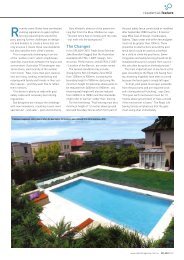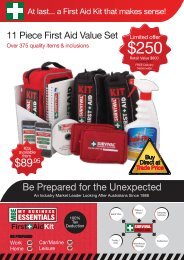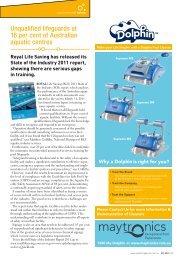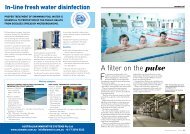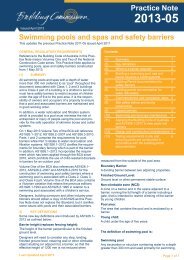Download PDF p1-48 - Splash Magazine
Download PDF p1-48 - Splash Magazine
Download PDF p1-48 - Splash Magazine
Create successful ePaper yourself
Turn your PDF publications into a flip-book with our unique Google optimized e-Paper software.
insurance update<br />
Industry members came out in force to Accent Heating’s HQ to learn about the new insurance regime from Jon East.<br />
NSW industry updated<br />
on insurance changes<br />
In August, SPASA NSW organised a<br />
meeting where Jon East, manager of the<br />
Home Warranty Insurance Fund (HWIF),<br />
a division of the Self Insurance Corporation<br />
(SICorp), explained the new system to assembled<br />
pool builders.<br />
Most of the details of the new home<br />
warranty insurance regime were covered<br />
in the August/September issue of SPLASH!<br />
However, several points were clarified in the<br />
occasionally lively August meeting.<br />
The first is that, contrary to fears in the<br />
industry, premiums are actually likely to go<br />
down. However, there may be extra costs to<br />
be borne if you go on the Managed Builder<br />
Program (MBP).<br />
SICorp is a not-for-profit branch of NSW<br />
Treasury. The organisation maintains that<br />
the main reason for insolvency (and consequent<br />
claims on Home Warranty Insurance)<br />
is poor business management. The new<br />
regime is designed to help pool building<br />
businesses operate with good management,<br />
which will help them be viable in the long<br />
term and reduce the risk of insolvency.<br />
The scheme also works on the belief that<br />
pool builders who manage their businesses<br />
properly and viably shouldn’t have to compete<br />
with underfunded builders who don’t<br />
know how to run their businesses.<br />
24 | SPLASH! www.splashmagazine.com.au<br />
There is a provision to ensure that the<br />
most a premium will cost a builder is 130<br />
per cent of what it would have cost them<br />
for the same job last year. This provision is<br />
scaled, rising 30 per cent per year until it<br />
reaches the normal premium price.<br />
However, it is anticipated that 90 per<br />
cent of builders will get a reduction in their<br />
premiums. To get a premium estimate, you<br />
can go to the HWIF website and use the<br />
premium calculator (www.homewarranty.<br />
nsw.gov.au or go to www.splashmagazine.<br />
com.au for a Quick Link).<br />
For example, the premium for a $42,000<br />
pool in the Hills District would cost $453.<br />
Builders will be obliged to take part in<br />
periodic reviews to resubmit their financials.<br />
However, this will not stop them from buying<br />
a policy. For major builders (>$20m turnover),<br />
SICorp will want to see some financials<br />
every quarter; if you’re between $5m and<br />
$20m, they’ll want to see financials every<br />
year; under $5m it will be every three years.<br />
Managed Builder Program<br />
Mark Batger of Home Warranty Insurance<br />
Specialists (HWIS) will be handling the<br />
Managed Builder Program. He has given<br />
SPLASH! a rundown of how it works.<br />
The bottom line is that builders for the<br />
first time have an option when applying for<br />
Home Warranty Insurance. Under the privately<br />
run scheme, if a builder failed to meet<br />
the insurer’s financial model, they simply<br />
couldn’t build.<br />
Under the Government’s scheme, they<br />
have recognised that difficult market conditions<br />
can affect a builder’s bottom line. That<br />
doesn’t mean the builder is a poor contractor<br />
but perhaps simply a victim of circumstance/timing.<br />
In any case, those builders<br />
represent a risk to the underwriter, and<br />
that’s where the MBP fits in.<br />
For those builders who do not meet the<br />
Home Warranty Fund’s financial model, they<br />
will be given three options:<br />
1. Capitalise their company to a level satisfactory<br />
to Home Warranty Fund (this is often<br />
not possible as they don’t have the cash);<br />
2. Sign a Deed of Indemnity over their<br />
personal assets (but often builders – and<br />
their wives – don’t want to tie up their<br />
personal assets);<br />
3. Enter the MBP.<br />
The MBP is a risk-management program<br />
run by independent private companies on<br />
behalf of the government. In effect, these<br />
companies provide a series of checks<br />
throughout the building contract period<br />
aimed at reducing the risk for the govern-






